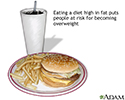Supporting your child with weight loss
The first step in helping your child get to a healthy weight is to talk with his or her doctor. Your child's health care provider can set healthy goals for weight-loss and help with monitoring and support.
Getting support from friends and family will also help your child lose weight. Try to get the whole family to join a weight-loss plan, even if weight loss is not the goal for everyone. Weight-loss plans for children focus on healthy lifestyle habits. All family members can benefit from having healthier lifestyles.
Food Discipline
Commend and reward your child when he makes good food choices and participates in healthy activities . This will encourage him to keep at it.
Food choices and participates in health...
No definition available for this article.
- DO NOT use food as a reward or punishment. For example, DO NOT offer food if your child does chores. DO NOT withhold food if your child does not do his homework.
- DO NOT punish, tease, or put down children who are not motivated in their weight-loss plan. This will not help them.
- DO NOT force your child to eat all the food on his plate. Infants, children, and teens need to learn to stop eating when they are full.
Show Them How to Do It
The best thing you can do to motivate your kids to lose weight is to lose weight yourself, if you need to. Lead the way and follow the advice you give them.
Tips to Help Along the Way
Try to eat as a family.
- Have meals where family members sit down and talk about the day.
- Set some rules, such as no lectures or teasing allowed.
- Make family meals positive experiences.
Cook meals at home and involve your children in the meal planning.
- Let children help prepare meals if they are old enough. If your children help decide what food to prepare, they are more likely to eat it.
- Homemade meals are often healthier than fast food or prepared foods. They can also save you money.
- If you are new to cooking, with a little practice, homemade meals can taste better than fast food.
- Take your children food shopping so they can learn how to make good food choices. The best way to keep kids from eating junk food or other unhealthy snacks is to avoid having these foods in your house.
- Never allowing any unhealthy snacks or sweets may result in your child sneaking these foods. It is OK to let your child have an unhealthy snack once in a while. The key is balance.
Help your children avoid tempting foods .
Children avoid tempting foods
No definition available for this article.
- If you have foods like cookies, chips, or ice cream in your house, store them where they are hard to see or reach. Put ice cream at the back of the freezer and chips on a high shelf.
- Move the healthier foods to the front, at eye level.
- If your family snacks while watching TV, put a portion of the food in a bowl or on a plate for each person. It is easy to overeat straight from the package.
What to do at School
School children can put pressure on each other to make poor food choices. Also, many schools do not provide healthy food choices.
Teach your children to avoid the sugary drinks in vending machines at school. Have your children bring their own water bottle to school to encourage them to drink water.
Pack a lunch from home for your child to bring to school. Add an extra healthy snack your child can share with a friend.
References
Hoelscher DM, Kirk S, Ritchie L, Cunningham-Sabo L; Academy Positions Committee. Position of the Academy of Nutrition and Dietetics: interventions for the prevention and treatment of pediatric overweight and obesity. J Acad Nutr Diet . 2013;113(10):1375-94. PMID: 24054714 www.ncbi.nlm.nih.gov/pubmed/24054714 .
-
Fast food - illustration
Fast foods are quick, reasonably priced, and readily available alternatives to home cooking. While convenient and economical for a busy lifestyle, fast foods are typically high in calories, fat, saturated fat, sugar, and salt and may put people at risk for becoming overweight.
Fast food
illustration
-
Fast food - illustration
Fast foods are quick, reasonably priced, and readily available alternatives to home cooking. While convenient and economical for a busy lifestyle, fast foods are typically high in calories, fat, saturated fat, sugar, and salt and may put people at risk for becoming overweight.
Fast food
illustration
-
Anorexia nervosa
(Alt. Medicine)
-
Scoliosis
(In-Depth)
-
Diabetes
(Alt. Medicine)
-
High blood pressure
(In-Depth)
-
Bipolar disorder
(In-Depth)
-
Viral hepatitis
(Alt. Medicine)
-
Periodontal disease
(In-Depth)
-
Back pain and sciatica
(In-Depth)
-
Anxiety disorders
(In-Depth)
Review Date: 4/21/2015
Reviewed By: Neil K. Kaneshiro, MD, MHA, Clinical Assistant professor of pediatrics, University of Washington School of Medicine, Seattle, WA. Also reviewed by David Zieve, MD, MHA, Isla Ogilvie, PhD, and the A.D.A.M. Editorial team.

